Pauli exclusion principle - Study guides, Class notes & Summaries
Looking for the best study guides, study notes and summaries about Pauli exclusion principle? On this page you'll find 143 study documents about Pauli exclusion principle.
Page 3 out of 143 results
Sort by
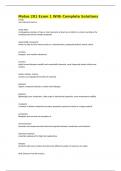
-
Matse 201 Exam 1 With Complete Solutions
- Exam (elaborations) • 11 pages • 2024
-
- $10.99
- + learn more
Matse 201 Exam 1 With Complete Solutions metals most elements exist as metal alloys a homogenous mixture of two or more elements at least one of which is a metal, and where the resulting material has metallic properties intermetallic compound similar to alloy but the mixture exists as a stoichiometric compound (distinct atomic ratios) ceramics inorganic, non-metallic substances ceramics solids formed between metallic and nonmetallic elements, most frequently oxides nitr...
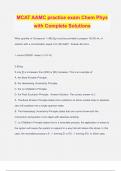
-
MCAT AAMC practice exam Chem Phys with Complete Solutions
- Exam (elaborations) • 34 pages • 2024
-
- $13.49
- + learn more
MCAT AAMC practice exam Chem Phys with Complete Solutions What quantity of Compound 1 (483.5g) must be provided to prepare 100.00 mL of solution with a concentration equal to Ki (60.3uM)? -Answer-M=mol/v 1 umol=0.000001 moles (1x10^-6) 2.92mg If only [I] is increased, then [ESI] or [EI] increases. This is an example of: A. the Bose-Einstein Principle. B. the Heisenberg Uncertainty Principle. C. the Le Châtelier's Principle. D. the Pauli Exclusion Principle. -Answer-Solution: The corr...
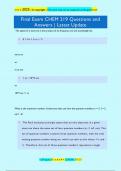
-
Final Exam CHEM 219 Questions and Answers | Latest Update
- Exam (elaborations) • 26 pages • 2024
-
- $12.49
- + learn more
The speed of a wave (c) is the product of its frequency (ν) and wavelength (λ). E = hv = h x c / λ nm to m or m to nm 1 m / 10^9 nm or 10^9 nm / 1 m What is the maximum number of electrons that can have the quantum numbers n = 3, ℓ = 2, mℓ = -2? The Pauli exclusion principle states that no two electrons in a given atom can share the same set of four quantum numbers (n, ℓ, mℓ, ms). This set of quantum numbers contains three quantum numbers, with the only missing qua...
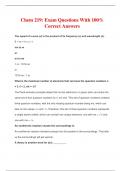
-
Chem 219: Exam Questions With 100% Correct Answers
- Exam (elaborations) • 19 pages • 2024
- Available in package deal
-
- $11.49
- + learn more
Chem 219: Exam Questions With 100% Correct Answers The speed of a wave (c) is the product of its frequency (ν) and wavelength (λ). E = hv = h x c / λ nm to m or m to nm 1 m / 10^9 nm or 10^9 nm / 1 m What is the maximum number of electrons that can have the quantum numbers n = 3, ℓ = 2, mℓ = -2? The Pauli exclusion principle states that no two electrons in a given atom can share the same set of four quantum numbers (n, ℓ, mℓ, ms). This set of quantum numbers contains thr...

-
MCAT AAMC practice exam Chem Phys Exam Questions and Answers 2024
- Exam (elaborations) • 23 pages • 2024
- Available in package deal
-
- $13.49
- + learn more
MCAT AAMC practice exam Chem Phys Exam Questions and Answers 2024 What quantity of Compound 1 (483.5g) must be provided to prepare 100.00 mL of solution with a concentration equal to Ki (60.3uM)? -Answer-M=mol/v 1 umol=0.000001 moles (1x10^-6) 2.92mg If only [I] is increased, then [ESI] or [EI] increases. This is an example of: A. the Bose-Einstein Principle. B. the Heisenberg Uncertainty Principle. C. the Le Châtelier's Principle. D. the Pauli Exclusion Principle. -Answer-Solution: ...

-
Grade 12 Chemistry: Structures and Properties of Matter
- Interview • 39 pages • 2023
- Available in package deal
-
- $7.99
- 1x sold
- + learn more
Grade 12 Chemistry Notes on the Structure and Properties of Matter. Includes topics varying from the current model of the atom, light, the photoelectric electric effect, the atomic line spectra, wave particle duality, heisenberg's uncertainty principle, quantum numbers, electron configuration, hund's rule, pauli exclusion principle, aufbau principle, orbital diagrams, electron configuration, valence bond theory and orbital hybridization, VSEPR, covalent bonding and polarity, periodic table tre...
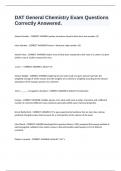
-
DAT General Chemistry Exam Questions Correctly Answered.
- Exam (elaborations) • 16 pages • 2024
-
- $13.99
- + learn more
DAT General Chemistry Exam Questions Correctly Answered. Atomic Number - CORRECT ANSWER number of protons found in that atom; low number; (Z) Mass Number - CORRECT ANSWER Protons + Neutrons; high number; (A) Atomic Mass - CORRECT ANSWER relative mass of that atom compared to the mass of a carbon-12 atom (which is set at 12.00); measured in amu; 1 amu = - CORRECT ANSWER 1.66x10^-24 Atomic Weight - CORRECT ANSWER weight (g) of one mole (mol) of a given element (g/mol); the weighte...
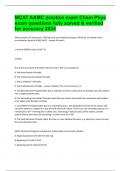
-
MCAT AAMC practice exam Chem Phys exam questions fully solved & verified for accuracy 2024
- Exam (elaborations) • 23 pages • 2024
- Available in package deal
-
- $14.49
- + learn more
What quantity of Compound 1 (483.5g) must be provided to prepare 100.00 mL of solution with a concentration equal to Ki (60.3uM)? M=mol/v 1 umol=0.000001 moles (1x10^-6) 2.92mg If only [I] is increased, then [ESI] or [EI] increases. This is an example of: A. the Bose-Einstein Principle. B. the Heisenberg Uncertainty Principle. C. the Le Châtelier's Principle. D. the Pauli Exclusion Principle. Solution: The correct answer is C. A. The Bose-Einstein Principle states that a co...
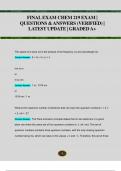
-
FINAL EXAM CHEM 219 EXAM | QUESTIONS & ANSWERS (VERIFIED) | LATEST UPDATE | GRADED A+
- Exam (elaborations) • 22 pages • 2024
-
- $11.49
- + learn more
The speed of a wave (c) is the product of its frequency (ν) and wavelength (λ). Correct Answer: E = hv = h x c / λ nm to m or m to nm Correct Answer: 1 m / 10^9 nm or 10^9 nm / 1 m What is the maximum number of electrons that can have the quantum numbers n = 3, ℓ = 2, mℓ = -2? Correct Answer: The Pauli exclusion principle states that no two electrons in a given atom can share the same set of four quantum numbers (n, ℓ, mℓ, ms). This set of quantum numbers contains three...
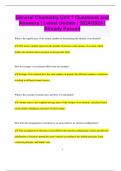
-
General Chemistry Unit 1 Questions and Answers | Latest Update | 2024/2025 | Already Passed
- Exam (elaborations) • 9 pages • 2024
- Available in package deal
-
- $9.75
- + learn more
General Chemistry Unit 1 Questions and Answers | Latest Update | 2024/2025 | Already Passed What is the significance of the atomic number in determining the identity of an element? The atomic number represents the number of protons in the nucleus of an atom, which defines the element and its position on the periodic table. How do isotopes of an element differ from one another? Isotopes of an element have the same number of protons but different numbers of neutrons, resulting in d...

That summary you just bought made someone very happy. Also get paid weekly? Sell your study resources on Stuvia! Discover all about earning on Stuvia


